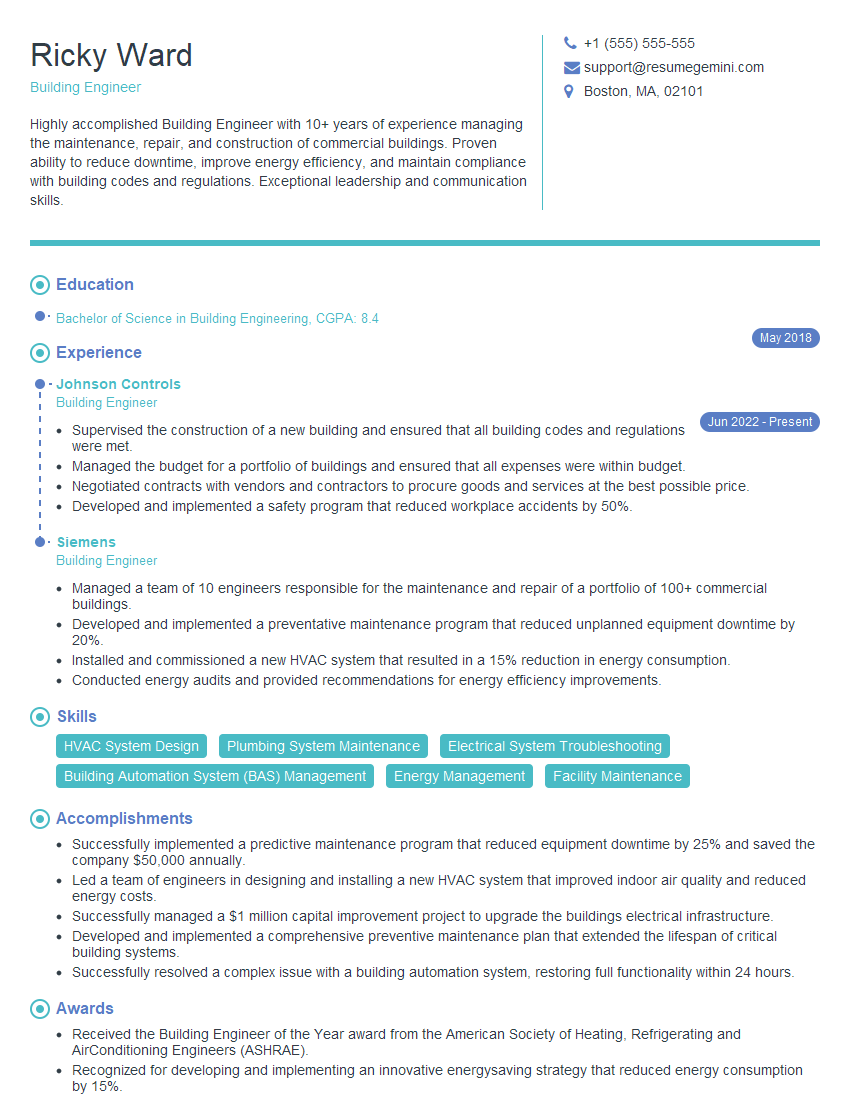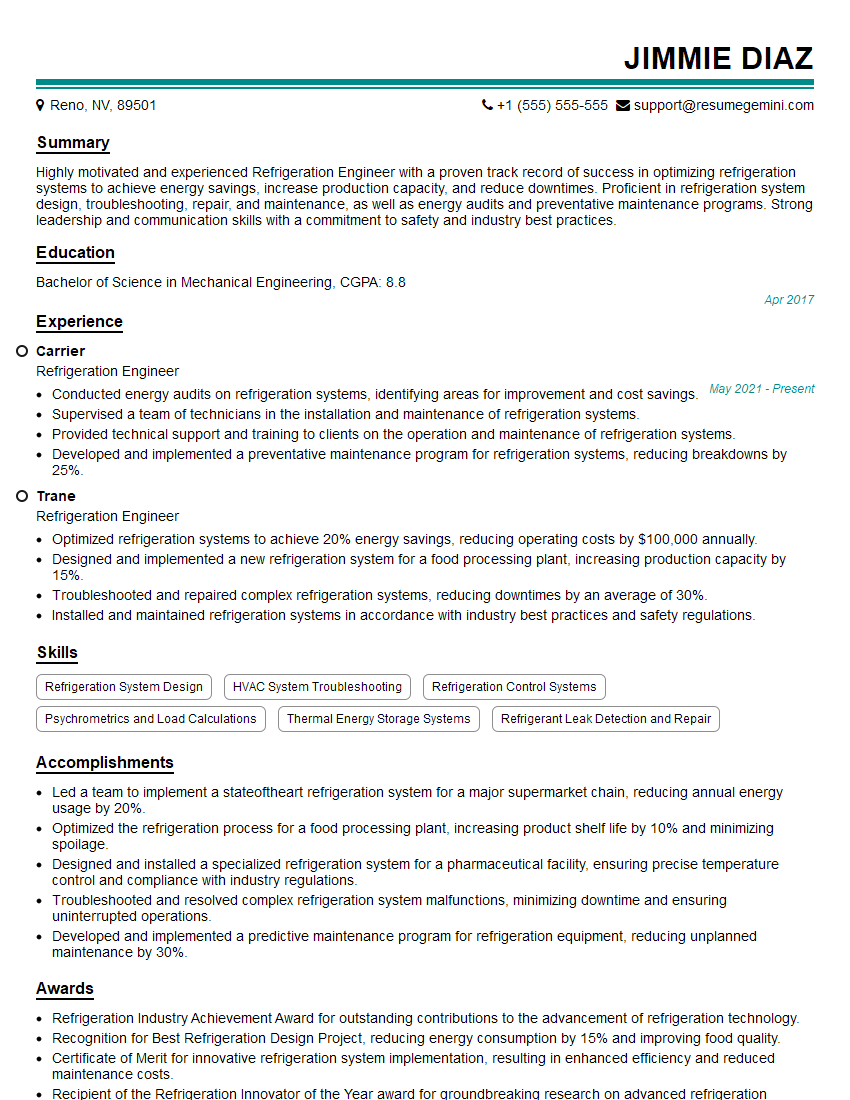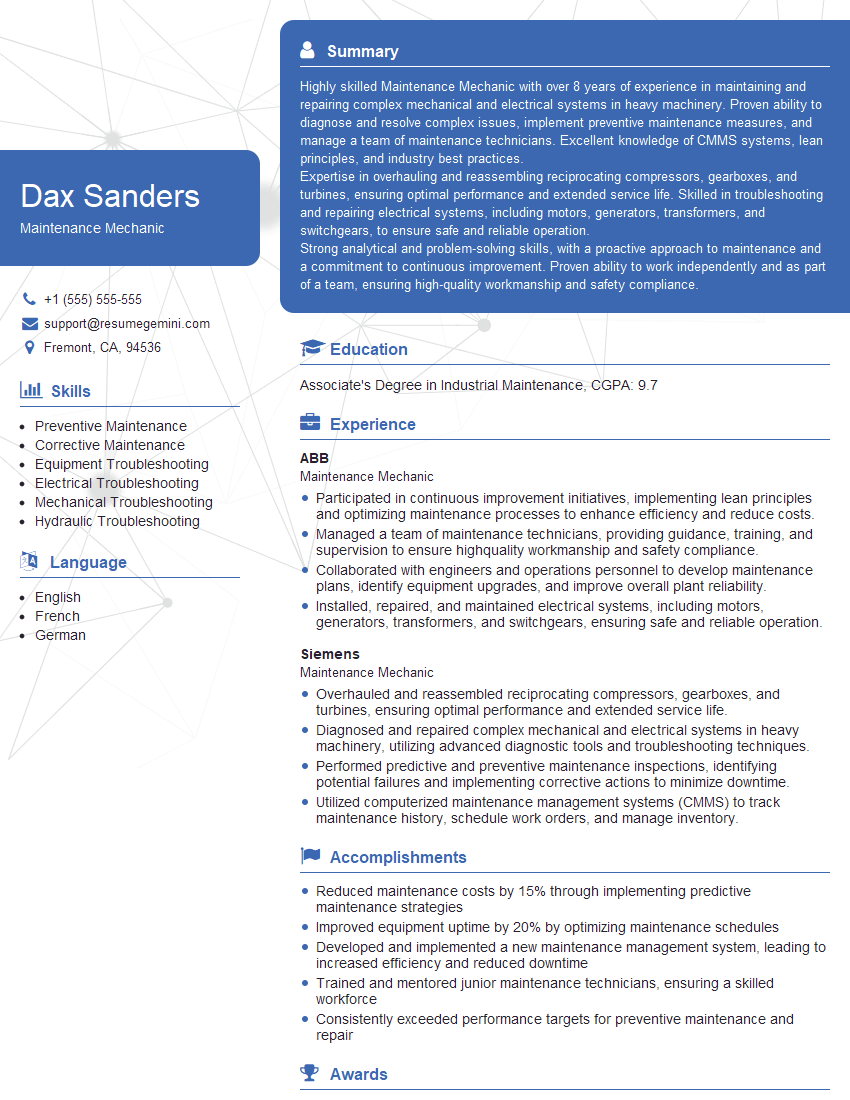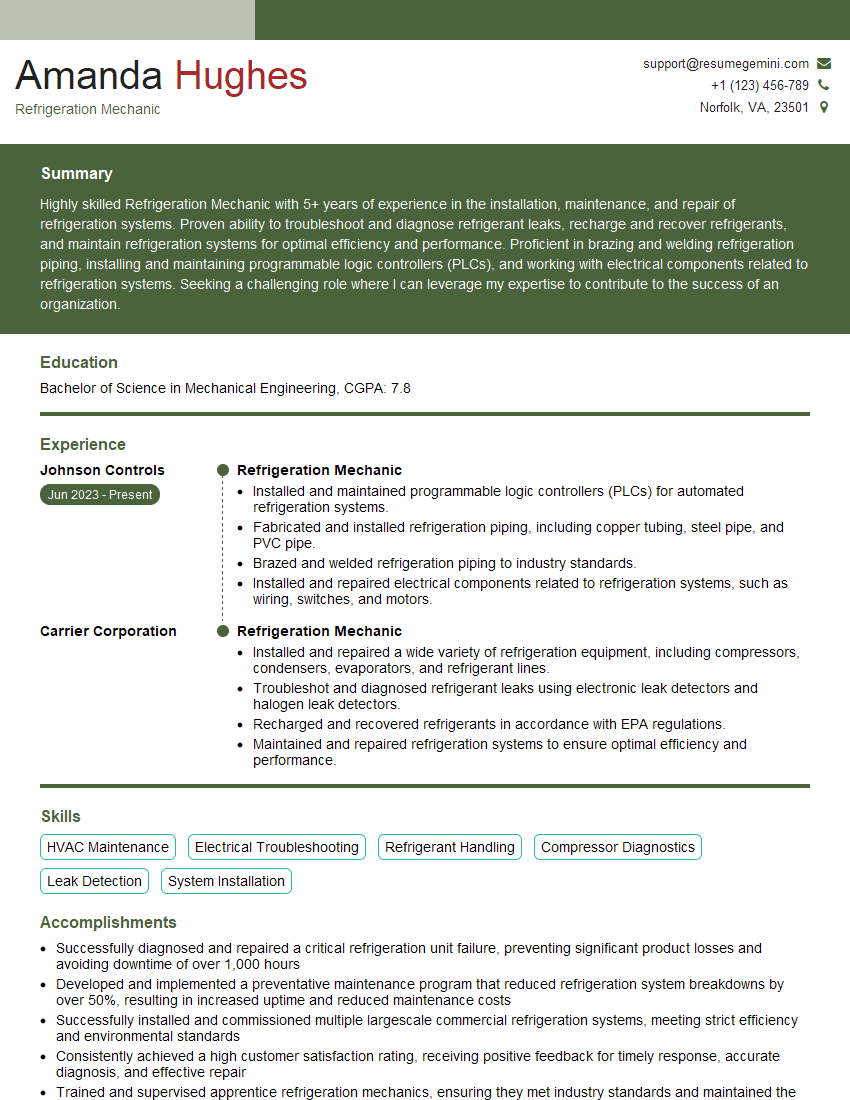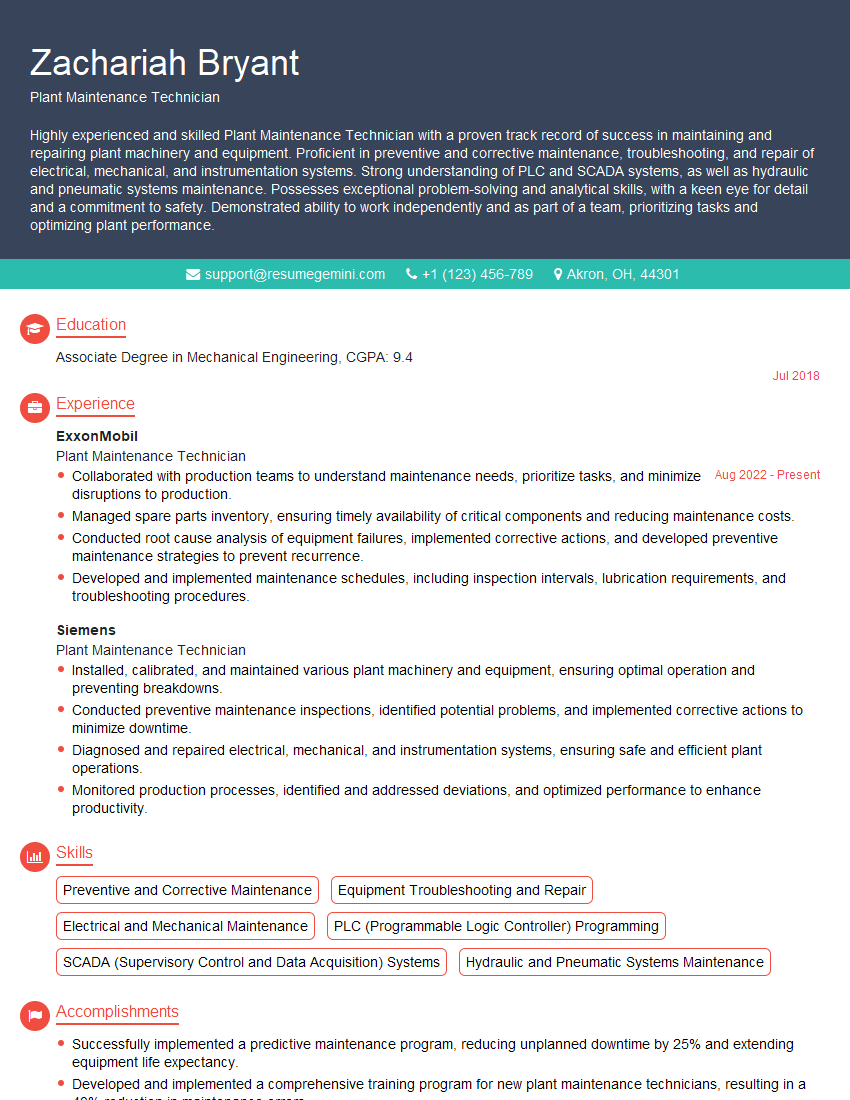Interviews are opportunities to demonstrate your expertise, and this guide is here to help you shine. Explore the essential Evaporator and Condenser Maintenance interview questions that employers frequently ask, paired with strategies for crafting responses that set you apart from the competition.
Questions Asked in Evaporator and Condenser Maintenance Interview
Q 1. Explain the function of an evaporator in a refrigeration cycle.
The evaporator is the heart of the refrigeration cycle’s cooling process. Think of it as the ‘cold spot’ where heat is absorbed from the space you want to cool. It’s a heat exchanger where a refrigerant, a special fluid that boils at a low temperature, changes from a liquid to a gas (vaporizes) by absorbing heat from its surroundings. This heat absorption lowers the temperature of the surrounding environment. Imagine a really cold sponge soaking up warmth from a hot room—that’s essentially what the evaporator does.
In a typical refrigeration system, the low-pressure, low-temperature refrigerant enters the evaporator. As it absorbs heat, it boils and evaporates, becoming a low-pressure, low-temperature gas. This gas then moves on to the compressor in the refrigeration cycle.
Q 2. Describe the function of a condenser in a refrigeration cycle.
The condenser is the opposite of the evaporator; it’s where the refrigerant releases heat and changes from a hot, high-pressure gas back into a liquid. Think of it as the ‘heat dumping’ station. The refrigerant, now a hot gas from the compressor, enters the condenser, where it’s cooled down. This cooling process is usually done by air or water, and it rejects the heat absorbed from the space being cooled into the surrounding environment.
This process transforms the refrigerant from a high-pressure gas into a high-pressure liquid. This liquid is then passed through an expansion valve to the evaporator, where the cycle repeats.
Q 3. What are the common types of evaporators and condensers?
Evaporators and condensers come in various designs, each best suited for specific applications. Common evaporator types include:
- Flooded evaporators: These are completely filled with refrigerant liquid, offering excellent heat transfer efficiency.
- Dry evaporators: Only a portion of the evaporator is wetted with refrigerant, making them good for situations with potentially fluctuating loads.
- Plate evaporators: These use thin plates to maximize surface area and heat transfer, often used in smaller systems.
Common condenser types include:
- Air-cooled condensers: Use fans to dissipate heat into the surrounding air; common in domestic refrigerators and smaller AC units.
- Water-cooled condensers: Use water to cool the refrigerant; more efficient than air-cooled but require a water source.
- Evaporative condensers: Combine air and water cooling, offering higher efficiency than air-cooled condensers alone.
Q 4. How do you troubleshoot a malfunctioning evaporator?
Troubleshooting a malfunctioning evaporator involves a systematic approach. First, check for obvious issues like ice buildup (indicating insufficient refrigerant or air circulation). Then, inspect the refrigerant lines for leaks using leak detection equipment. Low refrigerant levels will dramatically reduce cooling capacity.
Measure the temperature difference between the evaporator inlet and outlet. A smaller-than-expected difference signals poor heat transfer, potentially due to fouling or insufficient airflow. If the evaporator fan is not operating correctly, it needs to be repaired or replaced. Finally, check the expansion valve; a restricted valve will hinder refrigerant flow.
For example, if you find significant icing, it might indicate a restriction in the refrigerant flow, requiring further investigation of the expansion valve and refrigerant charge.
Q 5. How do you troubleshoot a malfunctioning condenser?
Troubleshooting a malfunctioning condenser follows similar steps: visually inspect for obvious problems such as excessive dirt or debris restricting airflow. Check the condenser fan operation and measure the temperature difference between inlet and outlet air or water streams; low temperature differences suggest poor heat rejection.
High head pressure readings are often a sign of a clogged condenser. Check for any leaks in the refrigerant lines using leak detection equipment. If the condenser is air-cooled, ensure proper air circulation is not hampered by obstructions. If water-cooled, verify sufficient water flow and check the cooling tower if applicable.
For instance, if you measure unusually high head pressure, you might suspect a dirty condenser, prompting a thorough cleaning.
Q 6. What are the common causes of evaporator fouling?
Evaporator fouling, the accumulation of unwanted substances on the evaporator surface, significantly reduces heat transfer efficiency. Common causes include:
- Dust and dirt: Particularly prevalent in environments with poor air filtration.
- Oil: Leaks from the compressor or other components can contaminate the evaporator.
- Frost and ice: Formed when the evaporator temperature drops below freezing due to insufficient refrigerant or airflow.
- Scale buildup: Mineral deposits from hard water in water-cooled systems.
- Biological growth: Bacteria and fungi can grow in damp environments.
Q 7. How do you clean and maintain an evaporator?
Cleaning and maintaining an evaporator is crucial for optimal performance and efficiency. The cleaning process depends on the type of evaporator and the nature of the fouling. Always disconnect the power before beginning any maintenance. For air-cooled evaporators, regular vacuum cleaning removes dust and debris. For more serious fouling, a chemical cleaning might be necessary using appropriate solvents, strictly following the manufacturer’s instructions. Always ensure complete drying before restarting the system.
Regular inspection and preventative maintenance, including checking refrigerant levels, inspecting for leaks, and ensuring proper airflow, prolongs the evaporator’s lifespan and prevents costly repairs. In some cases, professional cleaning services might be needed for complex systems.
Q 8. How do you clean and maintain a condenser?
Condenser cleaning and maintenance are crucial for optimal performance and longevity. Think of a condenser as the radiator of your refrigeration system; if it’s clogged, it can’t efficiently release heat. The process involves several steps, depending on the condenser type (air-cooled or water-cooled).
- Air-cooled condensers: These typically require regular cleaning of the fin coils. Dirt, dust, and debris restrict airflow, reducing efficiency. You’ll need a brush or vacuum cleaner with a soft brush attachment to gently remove the build-up. For stubborn dirt, a low-pressure water spray can be used, followed by thorough drying. Inspect fins for any damage and address them accordingly. Regular inspections (monthly for high-usage systems) are essential.
- Water-cooled condensers: These require cleaning of the internal water tubes and external surfaces. Scale and mineral deposits can accumulate, hindering heat transfer. Chemical cleaning might be necessary to remove stubborn scale. Regular water flow monitoring and occasional chemical treatment are crucial. A trained technician should perform this.
- General maintenance: Regardless of type, check for leaks, loose connections, and corrosion. Ensure proper airflow (for air-cooled) or water flow (for water-cooled) for efficient operation. Monitor the condenser’s temperature and pressure; significant deviations may indicate problems.
For example, I once worked on a supermarket refrigeration system where the air-cooled condensers were heavily clogged with dust and lint. A simple cleaning significantly improved efficiency, resulting in lower energy consumption and better cooling performance. Regular maintenance prevented costly repairs later.
Q 9. What are the safety precautions when working with evaporators and condensers?
Safety is paramount when working with evaporators and condensers, which often handle high pressures and potentially hazardous refrigerants. Always follow these precautions:
- Personal Protective Equipment (PPE): Wear safety glasses, gloves, and appropriate clothing to protect against refrigerant exposure, sharp edges, and electrical hazards.
- Lockout/Tagout Procedures: Before any maintenance, always disconnect power and lock out the system to prevent accidental starts. This is non-negotiable.
- Refrigerant Handling: Handle refrigerants responsibly, using appropriate recovery and recycling equipment to avoid environmental harm. Understand the hazards of the specific refrigerant used and follow the manufacturer’s safety data sheets. Never work with refrigerants in enclosed spaces without proper ventilation.
- High-Pressure Systems: Be aware of the high pressures within the system. Never attempt repairs or maintenance unless properly trained and equipped. Consult system schematics before working on any components.
- Emergency Procedures: Familiarize yourself with emergency procedures, including the location of fire extinguishers and first-aid kits.
Imagine the scenario: you’re servicing a condenser, and suddenly you encounter a pressure spike. Improper safety practices could lead to serious injury or equipment damage. Always prioritize safety.
Q 10. Explain the difference between air-cooled and water-cooled condensers.
The primary difference lies in how they reject heat:
- Air-cooled condensers dissipate heat to the surrounding air using fans to force air across finned coils. They are simpler, less expensive, and require less space, but their efficiency is dependent on ambient temperature. In hot climates, their performance can significantly decrease.
- Water-cooled condensers use water to absorb heat from the refrigerant. The heated water is then cooled in a cooling tower or other cooling system. They’re more efficient than air-cooled condensers, especially in hot environments, and offer more consistent performance. However, they require a water source, a cooling tower, and more complex plumbing, increasing initial cost and maintenance needs.
Think of it this way: an air-cooled condenser is like a radiator in a car; it relies on the air to cool it down. A water-cooled condenser is more like a car’s engine cooling system; it uses water to transfer heat away more efficiently.
Q 11. What are the different types of refrigerant used in evaporators and condensers?
The choice of refrigerant depends on various factors, including efficiency, environmental impact, and safety. Many older systems used refrigerants like R-12 (Freon), which are now phased out due to their ozone-depleting potential. Common modern refrigerants include:
- HFCs (Hydrofluorocarbons): R-134a, R-410A are widely used, but their global warming potential is a concern.
- HFOs (Hydrofluoroolefins): R-1234yf, R-1234ze are newer refrigerants with lower global warming potentials. These are becoming increasingly popular as more environmentally friendly options.
- Natural Refrigerants: Ammonia (NH3), Carbon Dioxide (CO2), and Propane (R-290) are environmentally friendly, but require specialized handling due to flammability or toxicity concerns.
Selecting the right refrigerant is a critical decision in system design and maintenance. Understanding the properties and regulations surrounding each refrigerant is essential for responsible operation.
Q 12. How do you identify refrigerant leaks?
Refrigerant leaks can be identified through several methods:
- Pressure Gauges: A gradual decrease in system pressure over time is a strong indicator of a leak. Regular pressure checks are essential.
- Electronic Leak Detectors: These devices use sensors to detect refrigerant escaping into the air. They are very sensitive and helpful in pinpointing leaks.
- Ultrasonic Leak Detectors: These listen for the high-frequency sound produced by escaping refrigerant, useful for finding leaks in hard-to-reach places.
- Visual Inspection: Check for visible signs of refrigerant escaping, like frost or oil stains around fittings, valves, or pipes.
- Dye Tracing: A dye is added to the refrigerant, and a UV lamp is used to locate the leak. This is effective for finding smaller leaks.
I recall a case where a subtle hissing sound near a valve was initially dismissed. Using an ultrasonic leak detector, however, we located a pinhole leak that was otherwise undetectable. Early detection prevented a significant refrigerant loss and potential system damage.
Q 13. What are the common causes of refrigerant leaks?
Common causes of refrigerant leaks include:
- Corrosion: Corrosion of pipes or fittings, especially in older systems, can create weak points and lead to leaks.
- Vibration: System vibrations can loosen connections or damage components over time.
- Mechanical Damage: Accidental damage during installation, maintenance, or operation can lead to leaks.
- Improper Installation: Poorly installed components or incorrect brazing techniques are frequent causes.
- Wear and Tear: The aging of components, such as seals and gaskets, can lead to leaks.
Preventing leaks through regular inspections, proper installation, and careful maintenance is far more cost-effective than addressing the consequences of a leak.
Q 14. How do you repair refrigerant leaks?
Repairing refrigerant leaks requires careful attention and expertise. The exact method depends on the leak’s location and severity. Small leaks in accessible areas can sometimes be repaired by replacing a damaged component or tightening a fitting. Larger or more complex leaks may necessitate brazing, welding, or component replacement.
- Brazing: This is a common technique for repairing leaks in copper tubing. It requires proper brazing equipment and expertise to avoid damaging the system.
- Welding: For certain materials, welding is used. This is a complex technique that requires specialized skills.
- Component Replacement: If the damage is extensive, replacing the entire component is the most reliable solution.
- Professional Assistance: Repairing refrigerant leaks often requires the expertise of a certified technician. Improper repair can compromise system safety and efficiency.
Remember, attempting to repair a refrigerant leak without proper training and equipment can be very dangerous. Always prioritize safety and seek professional assistance when necessary. I have seen instances where improper repairs led to further damage, necessitating more extensive and costly repairs.
Q 15. What is the role of a compressor in a refrigeration system?
The compressor is the heart of a refrigeration system. Its primary role is to pump refrigerant vapor, increasing its pressure and temperature. Think of it like a pump in your plumbing system, but instead of water, it circulates refrigerant. This pressurization is crucial because it allows the refrigerant to release its heat in the condenser, completing the refrigeration cycle.
In simpler terms, the compressor takes low-pressure, low-temperature refrigerant gas and transforms it into high-pressure, high-temperature gas. This high-pressure gas is then ready to release its heat in the next stage of the cycle.
Career Expert Tips:
- Ace those interviews! Prepare effectively by reviewing the Top 50 Most Common Interview Questions on ResumeGemini.
- Navigate your job search with confidence! Explore a wide range of Career Tips on ResumeGemini. Learn about common challenges and recommendations to overcome them.
- Craft the perfect resume! Master the Art of Resume Writing with ResumeGemini’s guide. Showcase your unique qualifications and achievements effectively.
- Don’t miss out on holiday savings! Build your dream resume with ResumeGemini’s ATS optimized templates.
Q 16. Explain the concept of superheat and subcooling.
Superheat refers to the temperature of the refrigerant gas after it has fully vaporized in the evaporator, but before it enters the compressor. It’s the amount of heat added beyond the saturation temperature at that specific pressure. Imagine boiling water: once it’s all steam, you can continue heating it, making it even hotter. That extra heat is analogous to superheat. It’s essential for preventing liquid refrigerant from entering the compressor, which can cause damage.
Subcooling, conversely, is the amount of heat removed from the refrigerant after it has fully condensed in the condenser, but before it enters the expansion valve. It’s the amount the liquid refrigerant is below its saturation temperature at that specific pressure. Subcooling ensures that only liquid refrigerant, not vapor, enters the expansion valve, again preventing issues and maximizing efficiency.
Q 17. How do you measure superheat and subcooling?
Measuring superheat and subcooling requires specialized tools: a thermometer and pressure gauges. You need to know the refrigerant’s saturation temperature and pressure at a given point in the system. You obtain this data using a refrigeration pressure-temperature chart specific to your refrigerant (like R-22, R-410A, etc.).
To measure superheat, measure the refrigerant’s actual temperature at the compressor suction line (after the evaporator). Then look up the saturation temperature corresponding to the suction pressure on the pressure-temperature chart. The difference between the actual temperature and the saturation temperature is the superheat.
Similarly, for subcooling, measure the refrigerant’s actual temperature at the condenser outlet (before the expansion valve). Look up the saturation temperature corresponding to the liquid line pressure. The difference between the saturation temperature and the actual temperature is the subcooling.
Many modern refrigeration gauges even display these values digitally, making the process incredibly straightforward. Remember to always consult the manufacturer’s instructions for your specific equipment.
Q 18. What is the importance of proper refrigerant charge?
Proper refrigerant charge is paramount for optimal system performance and efficiency. An incorrect charge directly impacts cooling capacity, energy consumption, and the longevity of your system components. Too little refrigerant leads to insufficient cooling, and too much can cause excessive pressure and potential damage. Think of it like the right amount of fuel in a car engine: too little and it won’t run properly, too much and it can cause damage.
Precise refrigerant charge ensures efficient heat transfer in both the evaporator and condenser, minimizing operational costs and preventing premature wear and tear. A properly charged system operates quietly and provides consistent cooling.
Q 19. How do you perform a refrigerant charge?
Refrigerant charging is a delicate procedure best left to trained professionals. However, the basic principles involve using a precise charging scale and carefully following the manufacturer’s recommendations for your specific system and refrigerant type. You can perform a charge using either a weight-based method (weighing the refrigerant as it’s added) or a subcooling-based method (charging until the desired subcooling is achieved). A vacuum pump is also used to evacuate the system before charging to remove any air or moisture that could contaminate the refrigerant.
Weight-based method: Weigh the refrigerant and add it until the specified amount is reached according to the system’s specifications.
Subcooling-based method: Charge the system until the desired subcooling value is reached, as measured with the gauge set. This method relies on measuring the subcooling in the liquid line as described earlier.
Remember that safety precautions are crucial during refrigerant handling, and improper handling can expose you to dangerous substances and lead to severe consequences. Always prioritize safety and follow relevant industry standards.
Q 20. What are the common problems associated with low refrigerant charge?
Low refrigerant charge manifests in several ways: reduced cooling capacity (the system struggles to reach the desired temperature), increased compressor run time (it has to work harder), frosting on the evaporator coil (indicating insufficient refrigerant to absorb heat effectively), and potentially higher energy consumption due to the prolonged operation of the compressor.
In extreme cases, you might even see elevated discharge temperatures at the compressor, potentially leading to compressor burnout. Early detection and correction are essential to prevent further damage.
Q 21. What are the common problems associated with high refrigerant charge?
A high refrigerant charge puts excessive pressure on the system, causing the compressor to work under strain and leading to potentially dangerous conditions. High pressure can cause increased discharge temperature (potential compressor damage), excessive liquid refrigerant in the compressor suction line (leading to liquid slugging and compressor failure), and reduced efficiency. The condenser may also struggle to dissipate heat efficiently resulting in higher operating pressures and increased risk of leaks.
It’s crucial to remember that overcharging is just as problematic as undercharging, and correct refrigerant charge is critical for the safe and efficient operation of any refrigeration system.
Q 22. Explain the concept of pressure drop in a refrigeration system.
Pressure drop in a refrigeration system refers to the decrease in pressure of the refrigerant as it flows through the various components. Think of it like water flowing through a pipe – the narrower the pipe, or the more obstructions it encounters, the higher the pressure drop. In a refrigeration system, this pressure drop is crucial for efficient heat transfer. A significant pressure drop indicates potential problems hindering the system’s performance.
The refrigerant’s pressure is highest at the condenser and lowest at the evaporator. This pressure difference drives the refrigeration cycle. A significant deviation from the expected pressure drop across components can signal inefficiencies or malfunctions.
Q 23. How do you measure pressure drop?
Measuring pressure drop involves using pressure gauges at specific points within the refrigeration system. We typically install gauges at the inlet and outlet of components like the evaporator, condenser, and expansion valve. The difference between the two readings gives us the pressure drop across that component. For example, if the inlet pressure to the condenser is 200 psi and the outlet pressure is 180 psi, the pressure drop across the condenser is 20 psi.
Modern systems often incorporate digital pressure transducers that provide continuous readings and can be monitored remotely, providing a much more comprehensive picture of the system’s pressure profile than traditional analog gauges.
Q 24. What are the common causes of pressure drop?
Several factors can contribute to excessive pressure drop in a refrigeration system. These include:
- Dirty or clogged filters or strainers: These restrict refrigerant flow, leading to increased pressure drop.
- Fouling or scaling in the evaporator or condenser: Build-up of ice, dirt, or other substances reduces the effective heat transfer area and increases resistance to flow.
- Restriction in the refrigerant lines: Bends, kinks, or constrictions in the piping can cause increased pressure drop.
- Insufficient refrigerant charge: A low charge can lead to increased pressure drop as the refrigerant struggles to flow through the system.
- Faulty expansion valve or capillary tube: These components regulate refrigerant flow; malfunctions lead to uneven pressure distribution.
- Air or non-condensables in the system: These non-condensable gases increase pressure in the condenser and reduce its efficiency.
Identifying the root cause requires a systematic approach involving visual inspection, pressure readings, and potentially specialized tools such as refrigerant analyzers.
Q 25. How do you troubleshoot high pressure in a refrigeration system?
High pressure in a refrigeration system can be a serious problem. Troubleshooting involves a methodical approach:
- Check the condenser fan motors and airflow: Restricted airflow, due to dirt or damage, causes high condenser pressure.
- Inspect the condenser coils for cleanliness: Clean or replace the condenser if necessary.
- Verify the refrigerant charge: An overcharge leads to excessively high pressure.
- Examine the condenser for leaks: Leaks may result in non-condensables entering the system.
- Check the operation of the expansion valve or capillary tube: Malfunctioning components can lead to high pressure.
- Check ambient temperature: High ambient temperatures put stress on the system leading to higher pressures.
Always remember safety precautions: High pressure is dangerous; use appropriate personal protective equipment and follow safety procedures.
Q 26. How do you troubleshoot low pressure in a refrigeration system?
Low pressure in a refrigeration system indicates potential issues requiring immediate attention. Here’s how to troubleshoot:
- Check the refrigerant charge: The most common cause is insufficient refrigerant. Leak detection is crucial.
- Inspect the compressor: A faulty compressor may not be pumping enough refrigerant.
- Examine the suction line: Check for blockages, restrictions, or leaks in the suction line, which carries low-pressure refrigerant from the evaporator to the compressor.
- Inspect the evaporator: Check for ice build-up, fouling, or other issues affecting heat transfer.
- Verify the expansion valve or capillary tube operation: Problems here can lead to inadequate refrigerant flow to the evaporator.
- Check for air or non-condensables in the system: These gases can obstruct refrigerant flow.
Remember to use appropriate equipment and follow safety procedures while handling refrigerants.
Q 27. What is the importance of regular maintenance of evaporators and condensers?
Regular maintenance of evaporators and condensers is essential for optimal system performance, energy efficiency, and longevity. Neglecting this can lead to significant costs and downtime.
- Improved Efficiency: Clean coils ensure efficient heat transfer, reducing energy consumption.
- Extended Lifespan: Regular cleaning prevents corrosion and premature wear, extending the life of the equipment.
- Reduced Downtime: Preventive maintenance proactively identifies and addresses potential issues, minimizing unexpected failures.
- Better Refrigerant Management: Regular inspection detects leaks and prevents refrigerant loss, reducing environmental impact and operational costs.
- Enhanced Safety: Proper maintenance ensures the system operates safely and reliably, reducing the risk of accidents.
For instance, I once worked on a system where neglected condenser cleaning led to a 20% increase in energy consumption. Regular cleaning would have avoided this significant cost.
Q 28. Describe your experience with different types of refrigeration systems.
Throughout my career, I’ve worked extensively with various refrigeration systems, including:
- Vapor-compression refrigeration systems: These are the most common type, utilizing a compressor, condenser, expansion valve, and evaporator.
- Absorption refrigeration systems: These use heat as the primary energy source instead of electricity, commonly found in industrial applications.
- Air-cooled systems: These use air to dissipate heat from the condenser, suitable for smaller applications.
- Water-cooled systems: These systems use water for heat rejection from the condenser, offering greater efficiency in larger installations.
My experience encompasses both commercial and industrial applications, including supermarkets, processing plants, and data centers. I’m familiar with various refrigerants and their handling procedures, including environmentally friendly alternatives such as R-410A and R-134a.
Key Topics to Learn for Evaporator and Condenser Maintenance Interview
- Refrigerant Handling and Safety: Understanding refrigerant types, proper handling procedures, leak detection methods, and safety regulations is crucial for both theoretical and practical application in the field.
- Evaporator Maintenance: This includes cleaning, defrosting, inspecting for leaks and corrosion, troubleshooting common evaporator issues (e.g., frosting, low airflow), and understanding the impact of different evaporator designs on efficiency.
- Condenser Maintenance: Focus on cleaning, inspecting for leaks and corrosion, identifying and resolving issues with airflow, understanding condenser pressure and temperature relationships, and recognizing signs of condenser failure.
- Troubleshooting and Diagnostics: Develop your ability to diagnose problems systematically using available tools and data, such as pressure gauges, temperature sensors, and amp meters. Practice identifying common malfunctions and developing effective solutions.
- Preventive Maintenance Schedules: Learn how to create and implement effective preventive maintenance schedules, including frequency of cleaning, inspection points, and necessary component replacements. Understanding the long-term cost savings and operational benefits is key.
- Understanding Pressure-Temperature Charts: Mastering the interpretation of pressure-temperature charts is essential for accurately assessing refrigerant charge, identifying leaks, and diagnosing system malfunctions.
- Component Identification and Function: Thoroughly familiarize yourself with the various components within evaporator and condenser systems, understanding their individual roles and how they interact as a whole.
- Energy Efficiency and Optimization: Learn about techniques for improving the energy efficiency of evaporator and condenser systems, such as optimizing airflow, reducing pressure drops, and selecting appropriate components.
Next Steps
Mastering Evaporator and Condenser Maintenance opens doors to rewarding and stable careers in HVAC, refrigeration, and related industries. Demonstrating a strong understanding of these systems is vital for securing your desired position. To significantly boost your job prospects, create a compelling and ATS-friendly resume that highlights your skills and experience. ResumeGemini is a trusted resource that can help you build a professional resume tailored to your experience, showcasing your expertise in Evaporator and Condenser Maintenance. Examples of resumes specifically designed for this field are available to help guide you. Take the next step in your career journey today!
Explore more articles
Users Rating of Our Blogs
Share Your Experience
We value your feedback! Please rate our content and share your thoughts (optional).
What Readers Say About Our Blog
Hello,
We found issues with your domain’s email setup that may be sending your messages to spam or blocking them completely. InboxShield Mini shows you how to fix it in minutes — no tech skills required.
Scan your domain now for details: https://inboxshield-mini.com/
— Adam @ InboxShield Mini
Reply STOP to unsubscribe
Hi, are you owner of interviewgemini.com? What if I told you I could help you find extra time in your schedule, reconnect with leads you didn’t even realize you missed, and bring in more “I want to work with you” conversations, without increasing your ad spend or hiring a full-time employee?
All with a flexible, budget-friendly service that could easily pay for itself. Sounds good?
Would it be nice to jump on a quick 10-minute call so I can show you exactly how we make this work?
Best,
Hapei
Marketing Director
Hey, I know you’re the owner of interviewgemini.com. I’ll be quick.
Fundraising for your business is tough and time-consuming. We make it easier by guaranteeing two private investor meetings each month, for six months. No demos, no pitch events – just direct introductions to active investors matched to your startup.
If youR17;re raising, this could help you build real momentum. Want me to send more info?
Hi, I represent an SEO company that specialises in getting you AI citations and higher rankings on Google. I’d like to offer you a 100% free SEO audit for your website. Would you be interested?
Hi, I represent an SEO company that specialises in getting you AI citations and higher rankings on Google. I’d like to offer you a 100% free SEO audit for your website. Would you be interested?
good


